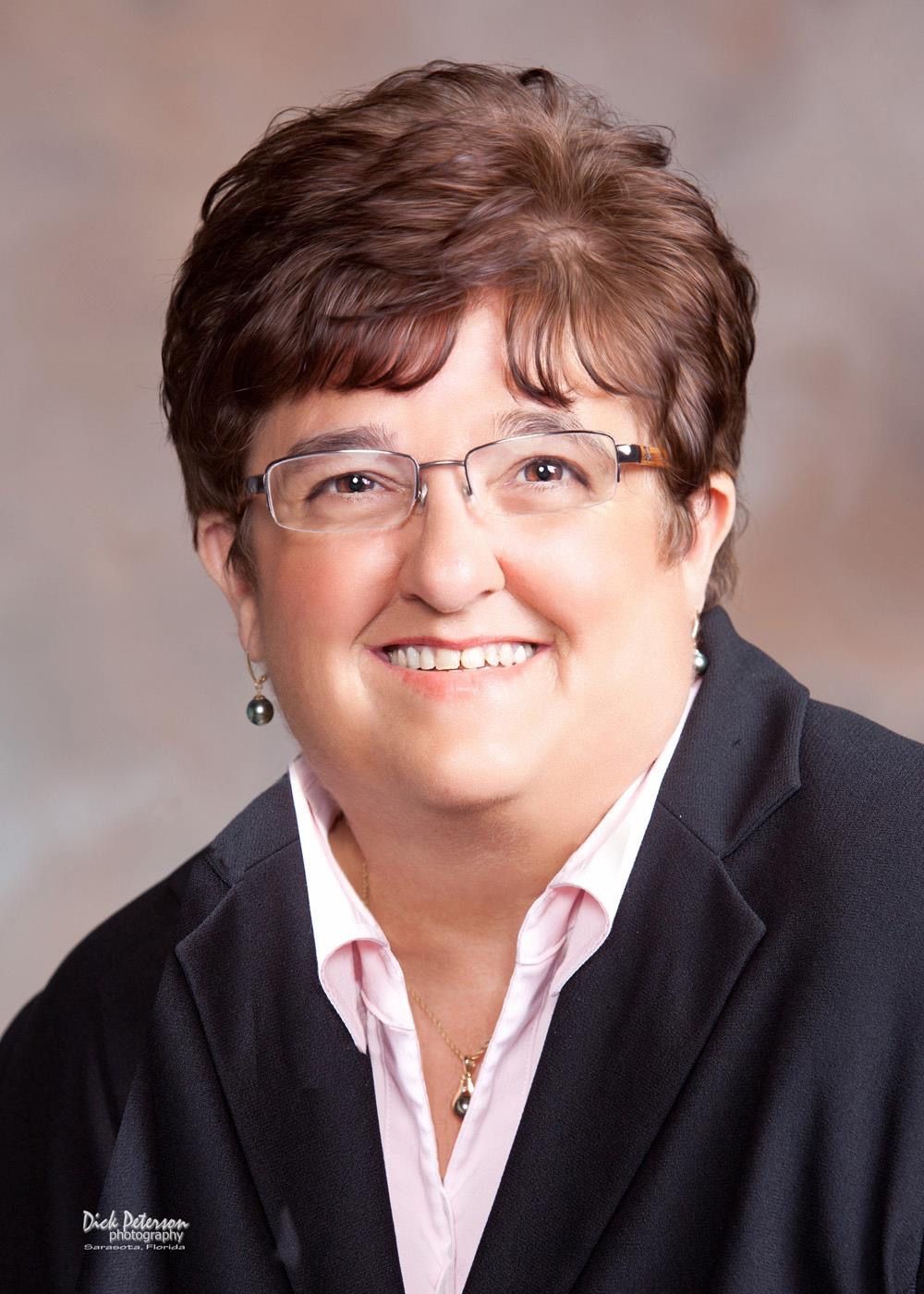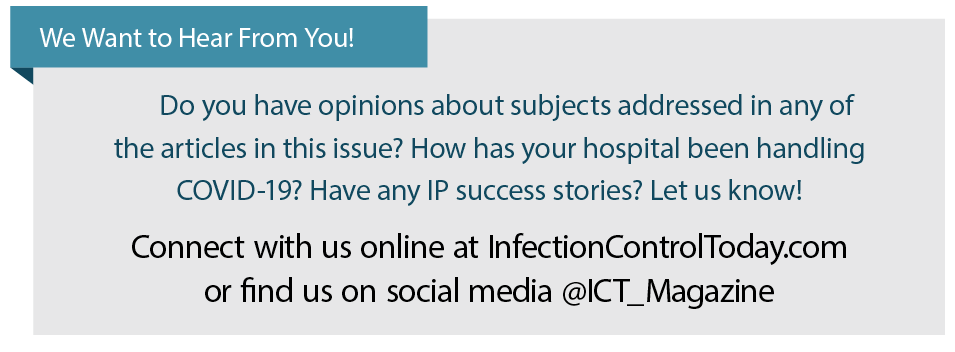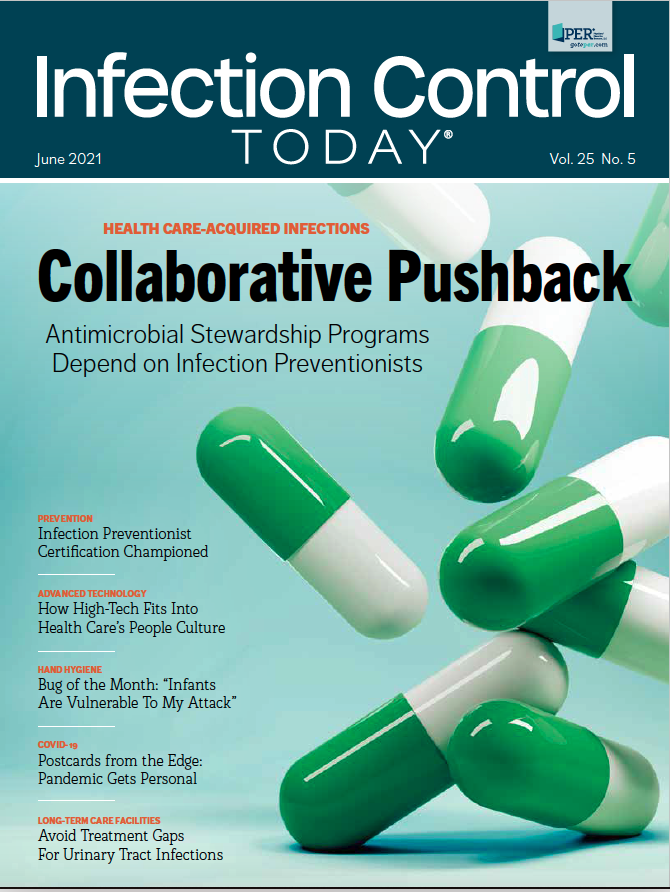Postcards From the Edge: Lessons Taught by COVID-19
One thing that will haunt me and many health care personnel in both acute care and LTCFs forever is that so many people died without a family member at their bedside.
I reached out to people in different disciplines, settings, and states. I wanted to know what lessons we’ve learned from the carnage caused by COVID-19 at various types of health care facilities, from acute care hospitals to long-term care facilities (LTCFs).
I had to do this because one thing that will haunt me and many health care personnel forever is that so many people died without a family member at their bedside.
Linda Spaulding, RN, BC, CIC, CHEC, CHOP

So many families will suffer forever knowing that they were not with their mother, father, brother, sister, grandparent, or child when that loved one died. This is not right, and we need to do better.
We need to take this experience that we've had with COVID-19 and make sure we develop ways to prevent anyone from dying alone or with the only connection to family being an iPad or a cell phone on their pillow.
We are better than this.
Where there is discussion and empathy, there is a solution to never letting this happen again. So, I reached out.
I spoke to a member of a purchasing department (sometimes called supply chain). I spoke to an infection preventionist (IP) in a pediatric acute care facility.
I talked to the director of quality and infection control in Port Angeles, Washington, as well as an administrator from Palolo Chinese Home in Honolulu, Hawaii.
They shared their stories.
RHONDA BOWEN, CIC, CPPS, CPHQ, CPHRM
INFECTION PREVENTIONIST
Olympic Medical Center in Port Angeles, Washington
Bowen has 15 years of experience in quality, patient safety, and patient experience evidence-based practices and is proactive with risk assessments and process improvement for quality and infection prevention. She is a certified infection preventionist who takes patient safety to heart. I met Bowen a few years ago when she was preparing her hospital for its Certification in Infection Prevention (CIP). Bowen is the director of safety and infection prevention and control. Olympic Medical Center holds the designation of CIP. This is a certification designated for the top hospitals in the United States, which few had been able to obtain. The certification is bestowed by DNV GL Healthcare, an independent foundation based in Cincinnati, Ohio, that accredits acute care and critical access hospitals. I asked Bowen how the hospital certification better prepared Olympic Medical Center for this pandemic.
“I think we have done well during COVID-19 because of our ability to work together within our organization and with our community partners, such as our local and neighboring public health teams and health care providers/clinics,” Bowen said. “Because of CIP, infection prevention and control is solidly integrated throughout our organization. CIP keeps us continuously focused on improvement and all things infection control, from hand hygiene and personal protective equipment [PPE] to antimicrobial stewardship, emergency management, and cleaning and disinfection. Incident command/senior leadership has led the way and been able to rapidly deploy and obtain resources when and where needed. Strong communication efforts, including multiple forums, communication tools, and just-in-time training have been effective in sharing the constantly evolving information and processes to our staff and patients. I think the most important thing for IPs to focus on is communication and rounding. You are a partner in staff and patient safety—a conduit of knowledge and empowerment. Continue building relationships by taking time every day to talk with staff at all organizational levels. Listen to their questions, concerns, and ideas. Assess how you can share or clarify information such as the disease/issue (to the best of our current knowledge), transmission, precautions, and effective cleaning processes, or just reassurance that they are doing what they are doing exactly right and thank them. And finally, for future pandemics…a healthy stock of PPE and essential cleaning supplies!”
DARIN YOSHIMOTO
LONG-TERM CARE FACILITY ADMINISTRATOR,
PALOLO CHINESE HOME
Honolulu, Hawaii
Yoshimoto has worked in the health care industry for more than 15 years, holding various positions, such as director of rehabilitation, activity, social services, and now administrator at a long-term care facility (LTCF) for the past 8 years. Because of his varied experience, he has been able to guide Palolo Chinese Home through the COVID-19 crisis. He wanted to share his thoughts on what he has learned.
“Infection control practices are a vital part of nursing facilities’ operations and procedures. Having a solid infection control program and plan, consistent implementation, and daily practice for all types of infection concerns is instrumental in facilities being prepared for any sort of new pandemic or infection influx.
“At this time most infection dangers will likely fall into already known categories for risks of spreading and exposure. Having strong practices in place best prepares facilities from the start to protect all individuals, whether it is from known dangers or a new pandemic, while the world needs time to learn and understand the infectious dangers.
“In the end, with COVID-19, the mitigation and protection strategies are known, although some are more commonly in practice than others.
“As we learned more about the COVID-19 virus, it was a matter of putting multiple strategies in place to defend ourselves against this new threat. We understood and practiced contact precautions, droplet precautions, proper use of PPE, and hand hygiene.
“With COVID-19, and its highly infectious nature, we also learned the level to which we must adapt procedures and be flexible to quickly implement new strategies as more knowledge is gained of new pandemic issues. We needed to incorporate social distancing, stringent mask wearing at all times for both residents and staff, and screening strategies in addition to what we were already doing. As this pandemic spread, COVID-19 taught valuable lessons: (1) the importance of having a strong infection control program and practices, and (2) the effectiveness of practices when implemented properly and consistently.”
ANONYMOUS
MANAGER, PURCHASING/
SUPPLY CHAIN DEPARTMENT
She is a registered nurse by trade with over 22 years of experience and manages a purchasing department. She knows the importance of value analysis and how important things like PPE are for frontline workers.
“Promoting better communication to staff throughout the hospital when replacement items are being distributed because the product the staff is used to using is no longer available [was something we learned on the fly]. Communication is important if staff is seeing a different item. If health care workers are used to using particular products, they might feel uncomfortable if they think the replacement items are inferior. Keep staff in the loop that they can expect to see a replacement item until the item they are used to is back in stock.
“Creating backups to the backup [is important, and] having a centralized database on the [specifications] for PPE, hand sanitizers, disinfectant wipes. If the heath care facility has a database of like PPE, then when there is a shortage of products, supply chain can go to see what is on list 2. If list 2 supplies are not available, they can go to list 3, knowing that the quality of the product is the same, it is just going to come from a different vendor. Vetting companies and products ahead of time decreases stress during a pandemic. Hospitals could use their IP department to assist them in reviewing products in advance. With the list of PPE, the company name, contact person, and phone number, product review should be done annually to be sure the list is still accurate, the company is still in business, and the quality of their product has not changed. This could be done by sending a single spreadsheet to the vendors of all their products on your list and asking them if the products still meet standards and are still the quality hospitals prefer.”
“There is a need to reassess the number of airborne isolation rooms the hospital has and [whether there is] a way to rapidly change the ventilation to provide more negative pressure rooms if the need arises. Assess alternatives to N95 masks to increase the numbers and types of masks that will provide the same protection. And there is a need to formalize and clearly define what is considered an aerosol-
generating procedure.
“Infection preventionists need to be at the table when designing and constructing new departments and work environments so airborne infection isolation rooms can be designed to meet the needs of a facility. Infection preventionists should work with industry leaders to identify new and innovative strategies to make standard patient rooms negative pressure that can be easily employed and cost-effective. IPs should work with their purchasing department leaders to identify products on the market that offer the same level of protection as N95 respirators and lobby NIOSH [the National Institute for Occupational Safety and Health] if alternatives are not sufficient.”
What I learned
If you had asked me 2 to 3 years ago how I think we would have handled a pandemic the magnitude of COVID-19, I would have said it would not go too smoothly.
I have never regretted being right so much.
I anticipated resistance from the general public because people who live in different regions of the country have different beliefs and thought patterns. Some are well-informed, and some are not. Some are followers; some are leaders. However, even in my worst-case imaginings, I would not have guessed it was going to be out of control for so many months.
For years, the federal government provided annual grants to hospitals and state agencies to prepare for any type of emergency, from a plane crash to bioterrorism to a pandemic.
Hospitals practiced drills annually and improved their emergency response plans. We knew who to contact for extra medical equipment. We had been told there were strategic stockpiles of PPE in various regions of the US that would be dispensed to hospitals if they needed it. The missing link was that in many regions of the country, LTCFs and assisted living communities (ALCs) were not included in the drills or in the funding for preparedness. These facilities were left on their own with no professional resources to help them develop a strong emergency preparedness program.
LTCFs and ALCs were set up to fail. Emergency managers in many states worked with acute care and neglected LTCFs. LTCFs were told, “Don’t worry, we will be here for you if something happens.” From my experience working with LTCFs—and I contract with more than 70 of them—this did not prove true when it mattered.
COVID-19 was transmitted among residents and staff of LTCFs, and patients were transferred from acute care hospitals to ill-prepared facilities because acute care ICUs were overwhelmed. LTCFs were not provided education or enough PPE, including N95 masks. Staff were not fit tested or taught how to use N95 masks properly. Staff in LTCFs never had N95 masks in the past because if there was a need for N95 masks that meant the resident had to be transferred to acute care.
They were on their own in many places across the country. Then COVID-19 happened and when they were told to use N95 masks, they couldn’t buy them because acute care was getting them, and they came last. It has been an epic failure on the part of federal, state, local, and facility emergency management programs.
So, as we move forward and out of the COVID-19 pandemic, emergency managers across the county will look at how to make improvements to their programs. Let us do it better next time. Let us take what we have learned and change how we provide health care, so we are better prepared for the next pandemic. Let us come up with ways to prevent people from dying alone. Let us be better prepared to stand on our own and not completely rely on federal, state, and local government. And better prepare all agencies that provide health care to focus on everyone’s preparedness, not just acute care facilities.
LINDA SPAULDING, RN, BC, CIC, CHEC, CHOP, is an infection prevention consultant and founder of InCo and Associates International.


Robust infectious disease surveillance, including rapid subtyping of influenza A, is essential for early detection, containment, and public health reporting of novel viral threats.